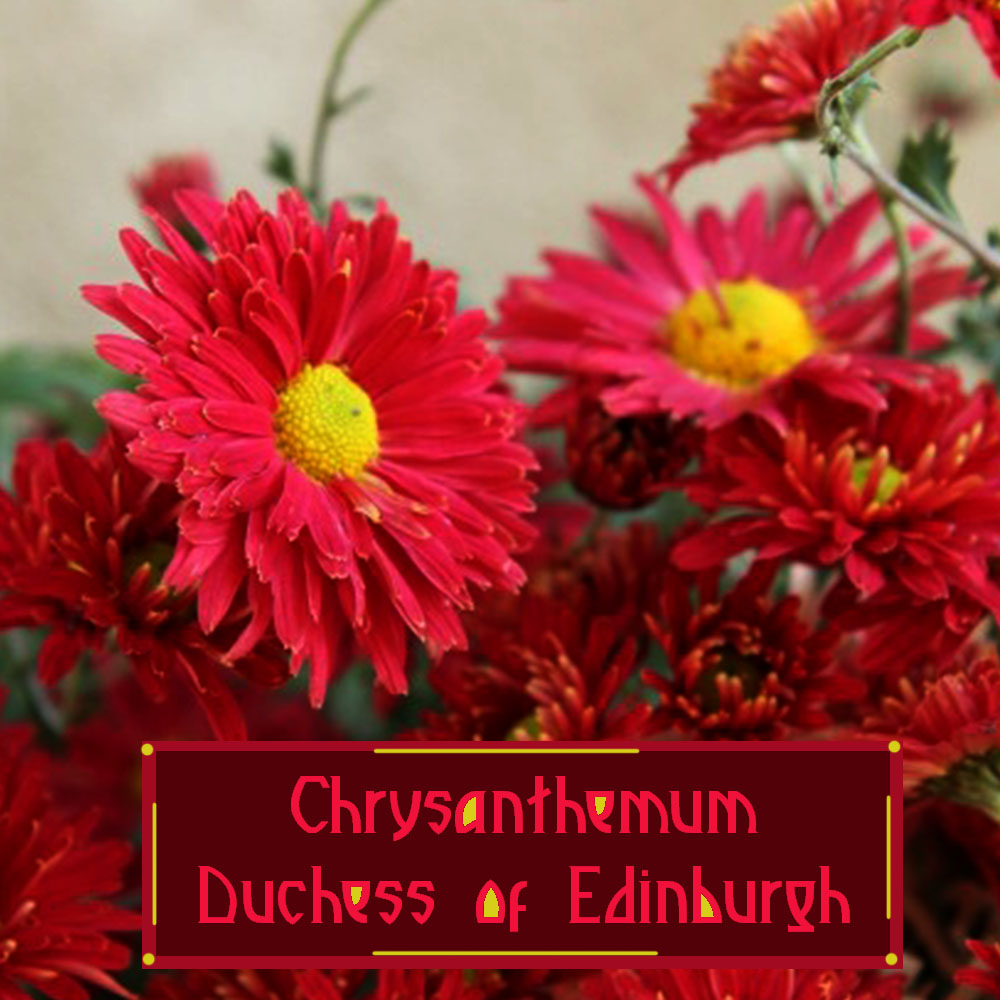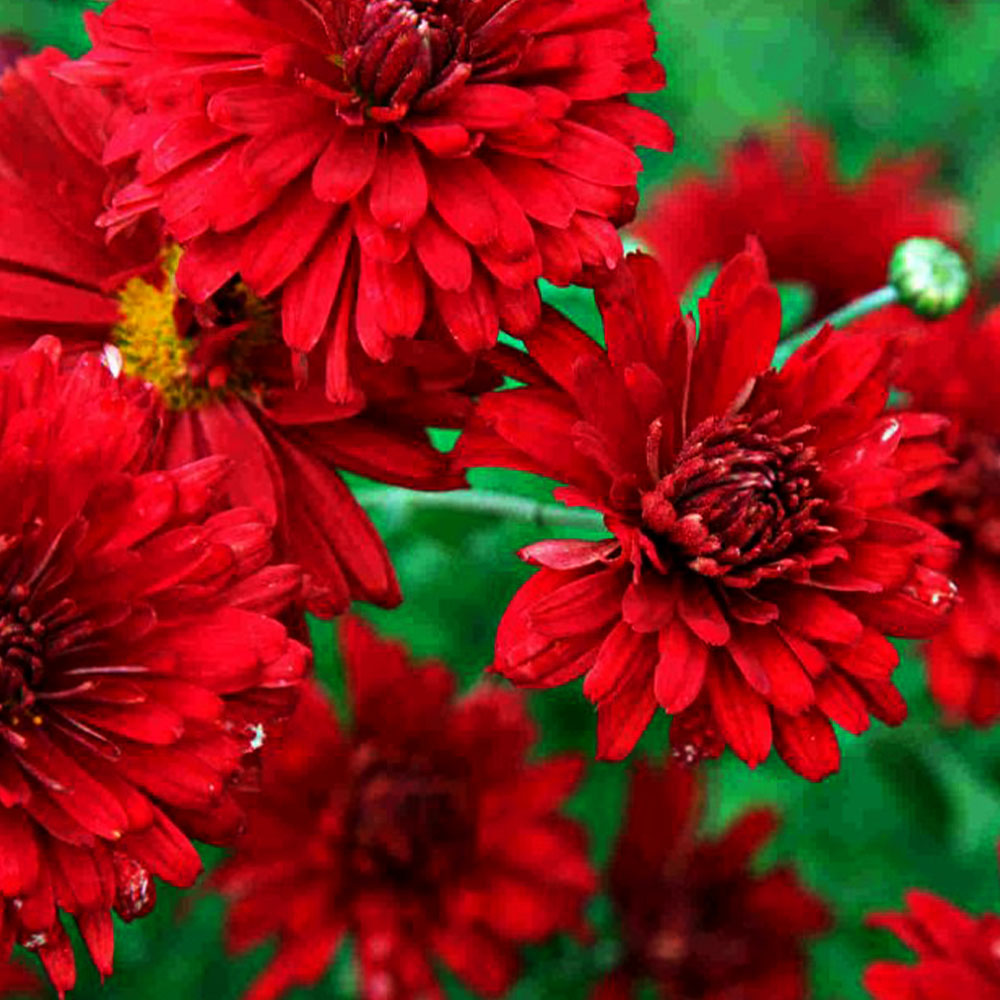-
 4,90 € × 1×€4.9
4,90 € × 1×€4.9
Customer matched zone "Locations not covered by your other zones"
“Chrysanthemum Duchess of Edinburgh” has been added to your cart. View cart
Chrysanthemum Duchess of Edinburgh
A perennial that produces many burgundy red double flowers
Rated 0 out of 5
0 customer reviews4,90 €
Only 15 item(s) left in stock!
Tags: chaud, comestible, couleur, feuillage persistant, graphique, perennial, persistant, plant, potted plant, secheresse, soleil, vivace, vivace en pot, xeriscaping
SKU: pda432
Category: Bees and Butterflies, Balcony-Friendly, Bouquet, Distillations, Evergreen, Fragrant, Frost Hardy, Ground Cover, Make it Pop, Rewild

Chrysanthemum Duchess of Edinburgh
4,90 €
Only 15 item(s) left in stock!
Chrysanthemum Duchess of Edinburgh is a compact, highly floriferous perennial that produces brick red, double flowers all throughout the autumn season.
The leaves are low-growing, green and divided into rounded leaflets, resembling miniature oak leaves. Chrysanthemum Duchess of Edinburgh turns slightly purplish as the cold weather sets in.
The flowers are doubled, a deep, velvety red with a bright yellow center. They are small but continuously blooming so the show feels never ending.
Drought tolerant and hardy, Chrysanthemum Duchess of Edinburgh will bring some color and energy to your garden as the other plants begin to prepare for winter.
👨🌾GARDENING TIPS👨🌾:
- 🌞 The active ingredient found in flower heads is called pyrethrum, and is a toxic compound that causes paralysis in insects. This is used in insecticides so you can infuse ho water with Chrysanthemum heads, let it cool and then spray your pests away! Alternatively, the flower heads can also be ground into a powder and sprinkled on a garden patch or windowbox that is giving you trouble – the pyrethrum should take care of them for you.
- ✂️ Cutting back the stems to 20cm from the ground in January promotes a strong reconstitution and multiplication of each Chrysanthemum when spring arrives.
- Chrysanthemum Duchess of Edinburgh loooks magnificent with Aster Henri Picot, Achillea Boule de Neige, Chrysanthemum Dernier Soleil
Continue learning about how to care for Chrysanthemums:
>> BBC Gardening – Chrysanthemum Grow Guide (In English)
>> Rustica – Comment Entretenir les Chrysanthèmes (In French)
The Tales & The Botany: Chrysanthemum Duchess of Edinburgh
One of the oldest references to be found concerning Chrysanthemum Duchess of Edinburgh is from The Floral Magazine (1875), in a plate showing “New Chrysanthemums.” The text describes Purple King and Duchess of Edinburgh as some of the coloured hybrids that were exhibited by Veitch & Sons at a Royal Horticultural Society exhibition that year. It is a bit unclear to me whether it is the same Duchess as the one we have today as they mention her having purple-red hues and a dark eye…. which we most definitely do not have. If anyone has any more information on this one- please don’t hesitate to write, I’m always so curious to know where a Duchess comes from!
The story of the chrysanthemum is as rich as its blooms are bright. Its name comes from the Ancient Greek words χρυσός (chrysos), meaning gold, and ἄνθεμον (anthemon), meaning flower — together, “golden flower.”
The etymology speaks not only to the luminous yellow of the earliest cultivated forms but also to the plant’s enduring place in human imagination as a symbol of brightness, endurance, and joy.
The genus Chrysanthemum has long been a point of spirited debate among botanists.
For centuries, it served as a catch-all for a diverse group of daisy-like plants — a great golden family that once embraced Argyranthemum, Glebionis, Leucanthemopsis, Leucanthemum (the true daisies), Rhodanthemum, and Tanacetum (the tansies).
This broad interpretation reflected the early, pre-Darwinian understanding of plant kinship, when classification relied primarily on visible form.
However, by the late 20th century, advances in cytology and molecular analysis revealed significant genetic distinctions between these groups.
A decisive ruling by the International Botanical Congress in 1999 formally resolved the confusion, refining Chrysanthemum to its modern definition — elegant, compact, and taxonomically sound.
Floral Morphology
Chrysanthemum species are famed for their dense, compound inflorescences, technically corymbose capitula, composed of hundreds of tiny florets.
Each inflorescence appears to be a single, full bloom — a sophisticated illusion of botanical architecture.
The inner disc florets are tubular and pentamerous, measuring about 15–20 mm in length, while the outer ray florets radiate in graceful symmetry.
Their colours range from deep magenta and rose pink to ivory white and golden yellow, depending on species and cultivar.
The texture of the petals, often velvety and luminous, amplifies their ornamental allure.
Reproductive Biology
The flowers of Chrysanthemum Duchess of Edinburgh are hermaphroditic and protandrous, meaning the male parts (anthers) mature before the female parts (stigmas).
This timing reduces the likelihood of self-fertilisation and encourages cross-pollination, while still allowing self-compatibility when pollinators are scarce.
Such a dual system ensures both genetic diversity and reproductive security — a fine evolutionary balance that explains the plant’s wide natural distribution and its success in cultivation.
Pollination is primarily mediated by insects, especially bees and butterflies, which are drawn to the plant’s copious nectar and bright visual cues.
The intricate flower structure and timing of pollen release make Chrysanthemum an instructive model in studies of reproductive ecology within the Asteraceae.
Ecology & Cultivation
In ecological terms, Chrysanthemum plays an important role as a late-season nectar source, sustaining pollinators when many other flowers have faded.
Flowering typically occurs from late summer through autumn, and the blooms persist for several weeks.
Regular deadheading (removal of spent flowers) encourages continued blooming and redirects energy toward the development of new inflorescences.
The plants prefer moderately dry, well-drained soils with low to medium fertility, thriving in full sun.
They are remarkably cold-tolerant, enduring light frosts and adapting comfortably to USDA hardiness zones 5–9.
Once established, chrysanthemums display both drought resistance and resilience against short-term waterlogging — traits that have made them beloved in diverse climates from Europe to East Asia.
Their adaptability, longevity, and brilliant autumn colour have earned chrysanthemums a reputation as the “flower of the fall.”
In gardens, they form bold borders, rich massifs, and enduring accents against the fading greens of late season.
For many cultures, especially in East Asia, they symbolize the endurance of life against the coming of winter — a living emblem of brightness that lingers when the rest of the garden sleeps.
Other names:
Mums
Chrysanths
Origin:
East Asia and northeastern Europe
Similaire
| Weight | 0,5 kg |
|---|---|
| Flower Color | 🔴 Red |
| Flowering | August, September, October |
| Exposure | Full Sun |
| Frost Tolerance | -15°C to -20°C |
| Soil | Dry, Well-Draining |
| Size | 0,5m H x 0,6m W |
Reviews
0
Rated 0 out of 5
0 customer reviews5
0
4
0
3
0
2
0
1
0
Only logged in customers who have purchased this product may leave a review.
You may also like…
Chrysanthemum Julie Lagravère
A perennial that produces many burgundy red flowers
A perennial that produces many burgundy red flowers
Rated 0 out of 5
Chrysanthemum Dernier Soleil
A perennial with large yellow flowers tipped with coppery-orange hues
A perennial with large yellow flowers tipped with coppery-orange hues
Rated 0 out of 5
Chrysanthemum Mei Kyo
A perennial with pink double pom-pom flowers
A perennial with pink double pom-pom flowers
Rated 0 out of 5
Related Products
Euphorbia cyparissias Clarice Howard
A Euphorbia that resembles a soft little cyprus tree
A Euphorbia that resembles a soft little cyprus tree
Rated 0 out of 5
Kalanchoe daigremontiana
A toothy succulent from Madagascar, known as the Mother of Thousands.
A toothy succulent from Madagascar, known as the Mother of Thousands.
Rated 0 out of 5
Trachelospermum asiaticum ‘Ogon Nishiki’
Jasmine with colorful foliage and lovely white flowers in summer
Jasmine with colorful foliage and lovely white flowers in summer
Rated 0 out of 5
Artemisia Valerie Finnis
A semi-evergreen, aromatic variation on the theme of Artemisia.
A semi-evergreen, aromatic variation on the theme of Artemisia.
Rated 0 out of 5
Erigeron kavinskianus
A daisy-like carpet of flowers
A daisy-like carpet of flowers
Rated 0 out of 5
Hieracium maculatum Leopard
A native perennial with blue-green leaves and a tall yellow flower
A native perennial with blue-green leaves and a tall yellow flower
Rated 0 out of 5
Euphorbia myrsinites
Known for its draping form of silver-gray foliage and radiant blooms.
Known for its draping form of silver-gray foliage and radiant blooms.
Rated 0 out of 5
Stachys byzantina
Silky white-grey leaves and tall striking flowers
Silky white-grey leaves and tall striking flowers
Rated 0 out of 5
Tanacetum densum subsp amani
A shrublet composed of soft, finely divided silvery gray-white leaves.
A shrublet composed of soft, finely divided silvery gray-white leaves.
Rated 0 out of 5
Tradescantia Blushing Bride
Gorgeous blushes of pink and white that appear in the coldest nights.
Gorgeous blushes of pink and white that appear in the coldest nights.
Rated 0 out of 5
Hellebore argutifolius
Winter flowering perennial with marbled blue-green leaves
Winter flowering perennial with marbled blue-green leaves
Rated 0 out of 5
Delosperma cooperi
A dwarf perennial known for its vermillion colored flowers
A dwarf perennial known for its vermillion colored flowers
Rated 0 out of 5
Cerastium tomentosum var. columnae
A grey-green spreading ground cover from the mountains.
A grey-green spreading ground cover from the mountains.
Rated 0 out of 5
Vinca minor
Looping elegance and ability to form a low flowering ground cover
Looping elegance and ability to form a low flowering ground cover
Rated 0 out of 5
Sedum album
A low, multi-color ground cover.
A low, multi-color ground cover.
Rated 0 out of 5
Glechoma hederacea
A sweet smelling ground cover, producing little blue flowers all summer long.
A sweet smelling ground cover, producing little blue flowers all summer long.
Rated 0 out of 5
Melissa officinalis
A perennial plant in the mint family that is adored by bees, royal families and tea drinkers.
A perennial plant in the mint family that is adored by bees, royal families and tea drinkers.
Rated 0 out of 5
Echinacea purpurea
A perennial with purple flowers all summer long
A perennial with purple flowers all summer long
Rated 0 out of 5
recent view product
Crassula tetragona
A succulent with dark green, sword-shaped leaves.
A succulent with dark green, sword-shaped leaves.
Rated 0 out of 5
Carex oshmensis Everest
A perennial grass loved for high arching, green and cream leaves
A perennial grass loved for high arching, green and cream leaves
Rated 0 out of 5
Carex hachijoensis ‘Evergold’
An evergreen perennial grass with striped yellow-gold foliage.
An evergreen perennial grass with striped yellow-gold foliage.
Rated 0 out of 5
Cistus creticus
Soft grey velvety velvety bush covered in bright pink flowers
Soft grey velvety velvety bush covered in bright pink flowers
Rated 0 out of 5
Lotus hirsutus
A semi-evergreen shrub with soft, silver-grey leaves that loves the sun
A semi-evergreen shrub with soft, silver-grey leaves that loves the sun
Rated 0 out of 5



















































There are no reviews yet.